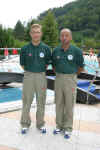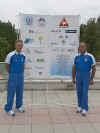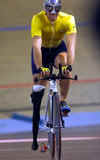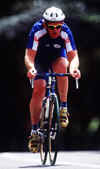|
|
|
|
|
Naši
športniki bodo nastopili v naslednjih panogah: |
|
|
|
 Seznanite
se z osnovami Paraolimpijskega kolesarstva - kliknite tukaj! Seznanite
se z osnovami Paraolimpijskega kolesarstva - kliknite tukaj!
Takšna
pa je sestava naše kolesarske reprezentance v Atenah 2004:
|
|
TEKMOVALCI |
ŽELJE
- NAPOVED |
MEDALJE |
|

|
David
Kuster |
|
|
|
TRENER
|
|
|
|

|
Anton
Kunaver
|
|
|
|
|

|
|
|
|
Prizorišča
kolesarskih tekmovanj
|
|
|
|
PREDSTAVITEV
PANOGE
|
|
KOLESARSTVO
|
|
 Bicycle
is one of the most popular means of transportation nowadays. It
is also one of the favourite recreational sports for people of
all ages. At first, Cycling became a sport for blind athletes
and athletes with vision impairment, who started competing with
tandem bicycles (bicycles with two saddles). Bicycle
is one of the most popular means of transportation nowadays. It
is also one of the favourite recreational sports for people of
all ages. At first, Cycling became a sport for blind athletes
and athletes with vision impairment, who started competing with
tandem bicycles (bicycles with two saddles).
 The
Paralympic Games Cycling programme includes two disciplines: Road
Cycling and
Track
Cycling. Road Cycling races take place on public highways,
while the Track Cycling races take place on tracks, or in other
words, a velodrome. Although the rules and regulations governing
the sport are the same as those for the Olympic Cycling, in
certain cases modifications to the bicycles are allowed in order
to facilitate athletes with specific disabilities. The
Paralympic Games Cycling programme includes two disciplines: Road
Cycling and
Track
Cycling. Road Cycling races take place on public highways,
while the Track Cycling races take place on tracks, or in other
words, a velodrome. Although the rules and regulations governing
the sport are the same as those for the Olympic Cycling, in
certain cases modifications to the bicycles are allowed in order
to facilitate athletes with specific disabilities.

Athletes
with partial or total vision impairment, celebral palsy, spinal
cord injuries, amputees or any other permanent physical
deficiency can participate in Cycling. The athletes are
classified into categories
based on their functional abilities together with the skills
required for the sport. The athletes’ bicycles are modified,
whenever considered necessary, according to the athletes’
needs.
Cycling
at the 2004 Paralympic Games
Track
Cycling events will be held in the
Olympic
Velodrome
at the Athens Olympic Sports Complex (OCO), within
five competition days (18-22 September 2004). Road Cycling
events will be held in
Vouliagmeni,
within the span of three competition days, from 24-26 September
2004.
|
|
Cycling
is a relatively new sport for athletes with a
disability. At the beginning of the eighties blind
athletes and athletes with vision impairment began
participating in Cycling competitions. Athletes with
cerebral palsy and amputees first competed during the
1984 International Games for the Disabled.
The
inclusion of Road Cycling in the competition programme
of the 1988 Paralympic Games, in Seoul, constituted a
milestone in the history of Cycling. Until the 1992
Paralympic Games in Barcelona, athletes in every
disability class competed separately. The Track Cycling
events were first included in the Paralympic Games
programme, in 1996, in Atlanta.
The
International Cycling Union (Union Cycliste
Internationale – UCI), which was founded in Rome in
1900 and the Cycling Committee of the International
Paralympic Committee, are responsible for the
institution of the rules and regulations governing the
sport and for the sports’ development worldwide.
|
|
|
|
|
During
competition, training and warm-up sessions at official
competition venues, athletes have to wear a helmet.
The
helmet’s colour depends on the athlete’s class:
|

|
Athletes
in the men’s Tandem, LC1 and Group 2 classes
must wear a red helmet,
|
|

|
Athletes
in the mixed Tandem, LC3 and Group 3 classes
must wear a blue helmet,
|
|

|
Athletes
in the LC4 and Group 1 classes must wear a green
helmet,
|
|

|
Athletes
in the women’s Tandem, LC2 and Group 4 classes
must wear a white helmet.
|
|
|
|
|
|

|
 Athletes
with a different kind and level of disability are
competing at the Paralympic Games. In order to
compete on equal terms, athletes are classified
into different classes. Specialised medical and
technical personnel, called classifiers, perform
classification assessment. They are evaluating the
athletes with various procedures and tests based
on their functional ability to perform skills
required by the sport. In that way it is
guaranteed that the athletes competing within a
class have equal or similar functional abilities.
The International Paralympic Committee is the
competent authority for all matters related to
Cycling for athletes with a disability. Some of
the rules that are followed for the cyclists’
classification are listed below. Athletes
with a different kind and level of disability are
competing at the Paralympic Games. In order to
compete on equal terms, athletes are classified
into different classes. Specialised medical and
technical personnel, called classifiers, perform
classification assessment. They are evaluating the
athletes with various procedures and tests based
on their functional ability to perform skills
required by the sport. In that way it is
guaranteed that the athletes competing within a
class have equal or similar functional abilities.
The International Paralympic Committee is the
competent authority for all matters related to
Cycling for athletes with a disability. Some of
the rules that are followed for the cyclists’
classification are listed below.
Classes: Vision
impaired and blind athletes Locomotor
Disabled Locomotor
Disabled Cerebral
Palsy Cerebral
Palsy Handcycling Handcycling
Vision
impaired and blind athletes
Blind
or visually impaired athletes compete on the rear
of tandem bicycles, along with a sighted athlete,
and are classified into three classes:
|
B1:
|
Athletes
with no light perception in either eye,
and athletes with light perception who are
unable to recognise the shape of a hand at
any distance or in any direction are
categorised as B1 athletes.
|
|
B2:
|
Athletes
who are able to recognise the shape of a
hand up to visual acuity of 2/60 and/or
visual field of less than 5 degrees, are
categorised as B2 athletes.
|
|
B3:
|
Athletes
with visual acuity of 2/60 up to 6/60
and/or visual field of more than 5 degrees
and less than 20 degrees are categorised
as B3 athletes.
|
Note: All classifications are in
the best eye with the best correction, i.e., all athletes who use contact or corrective lenses must
wear them for classification, whether they intend
to wear them in competition or not.
athletes who use contact or corrective lenses must
wear them for classification, whether they intend
to wear them in competition or not.
Athletes
with Locomotor Disabilities (LC)
Athletes
with a physical (locomotor) disability compete in
four different classes: LC1, LC2, LC3 and LC4,
where men and women compete together. Both men and
women athletes are classified according to the
same rules. However, women compete in one lower
class level than the one in which the men with the
respective degree of disability are classified.
Eg., while a woman athlete might be classified in
LC1, she will compete with cyclists in the LC2
class.
|
LC1:
|
Athletes
with minor or no lower limb disability are
classified as LC1 athletes. Some examples
of minimum disability of LC1 athletes are
the following:
|
|
|

|
Amputation
of more than half-foot.
|
|
|

|
Leg
length difference of 7-12 cm.
|
|
|

|
Deformations
of the spine which makes riding in a
normal aerodynamic position not possible.
|
|
LC2:
|
Athletes
with disabilities in one leg, who are able
to pedal normally using both legs, with or
without prostheses, are classified as LC2
athletes. Some examples of minimum
disability of LC2 athletes are the
following:
|
|
|

|
Single
above- or below-knee amputation with
prosthesis.
|
|
|

|
Leg
length difference of more than 12 cm.
|
|
|

|
Amputation
or paralysis of both upper limbs with
artificial handgrips on one or both sides.
|
|
LC3:
|
LC3:
Athletes with disabilities in one lower
limb (with or without upper limb
disabilities), most of whom pedal using
one leg, are classified as LC3 athletes.
Some examples of minimum disability of LC3
athletes are the following:
|
|
|

|
Single
above- or below-knee amputation without
prosthesis, or with prosthesis such that
the radius of rotation of pedal on the
amputated side is 0 (zero) or not more
than 6 cm.
|
|
|

|
Double
below-knee amputation, with prostheses.
|
|
|

|
One
lower limb not functional for normal
pedaling, for example: radius of rotation
of pedal is not more than 6 cm.
|
|
LC4:
|
Athletes
with more severe disabilities, which
usually affect both lower limbs (with or
without upper limb disabilities), are
classified as LC4 athletes. Some examples
of minimum disability of LC4 athletes are
the following:
|
|
|

|
Double
above-knee amputation, with one or two
prostheses.
|
|
|

|
Single
above-knee amputation and amputation of
upper member, without leg prosthesis and
holding the handlebar with only one hand.
|
|
|

|
Combination
of above-knee and below-knee amputation
with one or two prostheses.
|
Cerebralna
paraliza (CP)
Athletes
with cerebral palsy compete in four different
divisions: CP division 1, CP division 2, CP
division 3 and CP division 4. Men and women
cyclists compete together on equal terms.
| CP
Division 4: |
The
least severely disabled athletes, who race
on bicycles, are classified in this
division. Division 4 equates to CP-ISRA
Classes 8 and 7. An example of minimum
disability is the following:
|
|
 |
Possible
loss of function by uncoordinated hands or
one leg |
| CP
Division 3 and 2: |
Athletes
in these divisions can choose whether they
will compete on bicycles (Division 3), or
tricycles (Division 2). Both divisions
equate to CP-ISRA Classes 6 and 5. An
example of minimum disability is the
following: |
|
 |
Balance
problems and difficulty with seated
balance and control. |
| CP
Division 1: |
The
more severely disabled athletes, who race
on tricycles, are classified in this
division. Division 1 equates to CP-ISRA
Classes 4, 3, 2 and 1. An example of
minimum disability is the following: |
|
 |
Poor
functional strength in trunk and all
extremities
|
Handcycling
(HC)
Handcycling
athletes compete in two disability divisions: HC
Division 4/3 and HC Division 2/1,
with separate events for men and women. Athletes
who, in their daily life use wheelchairs for
general mobility, or athletes with severe
deficiency in their lower limbs who are not able
to compete with a bicycle or tricycle, are
classified as Handcycling athletes.
One example of minimum disability of HC Division
4/3 athletes is the following:
 |
Paraplegic
or leg amputee with full trunk stability |
Some
examples of minimum disability of HC Division 2/1
athletes are the following:
 |
Tetraplegic,
quadriplegic or paraplegic |
 |
Limited
use of arms and hands |
Also
see:  
|
|
|
|
|
.gif) .gif)
|
 The
Paralympic Games Cycling programme includes two
disciplines: Road Cycling and Track Cycling. Road
Cycling races take place on public highways, while the
Track Cycling races take place on tracks, or in other
words, a velodrome. Although the rules and regulations
governing the sport are the same as those for the
Olympic Cycling, in certain cases modifications to the
bicycles are allowed in order to facilitate athletes
with specific disabilities. The
Paralympic Games Cycling programme includes two
disciplines: Road Cycling and Track Cycling. Road
Cycling races take place on public highways, while the
Track Cycling races take place on tracks, or in other
words, a velodrome. Although the rules and regulations
governing the sport are the same as those for the
Olympic Cycling, in certain cases modifications to the
bicycles are allowed in order to facilitate athletes
with specific disabilities.
Athletes
with partial or total vision impairment, celebral palsy,
spinal cord injuries, amputees or any other permanent
physical deficiency can participate in Cycling.
Also
see: 
|
|
|
|
|
|
|
|
|
|
|




















